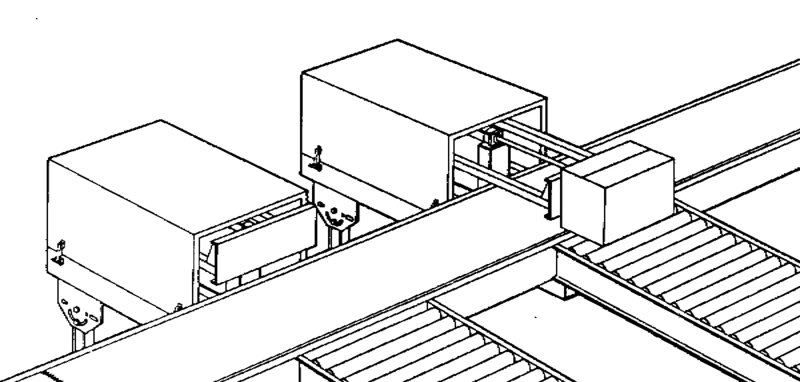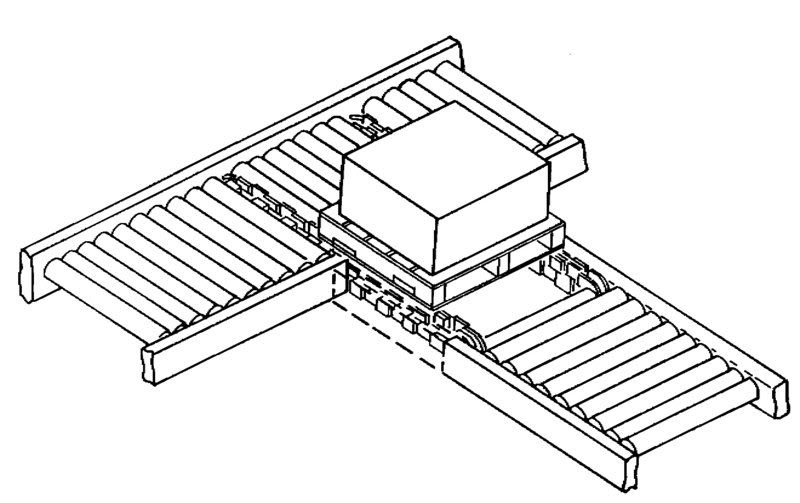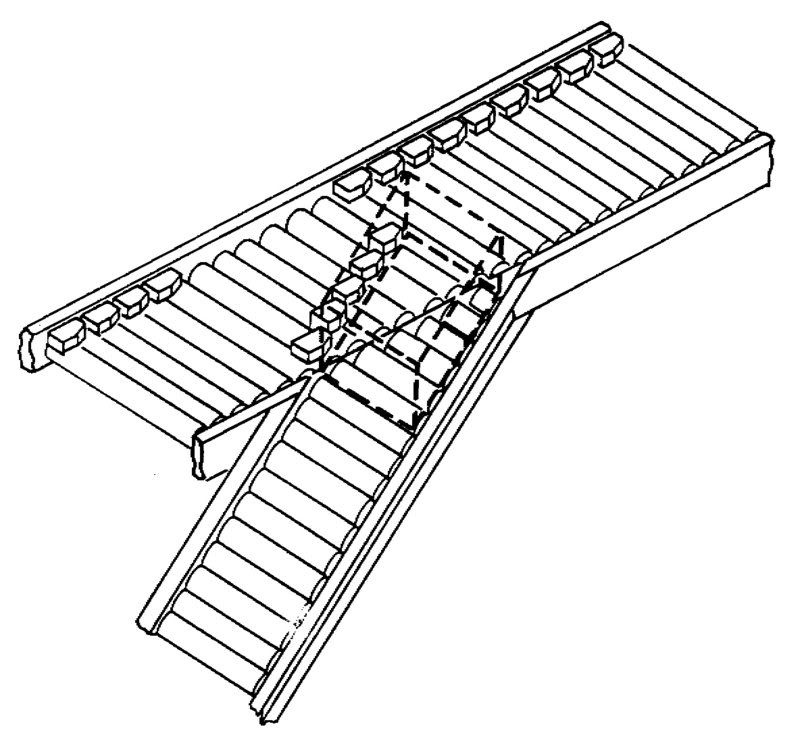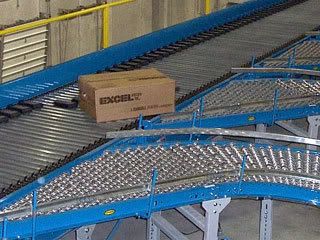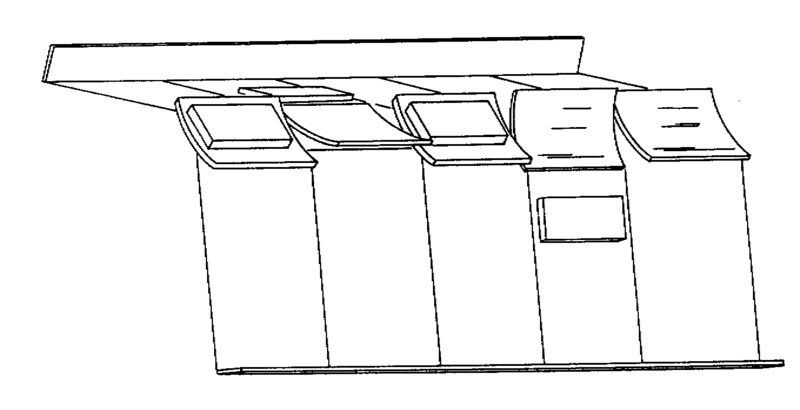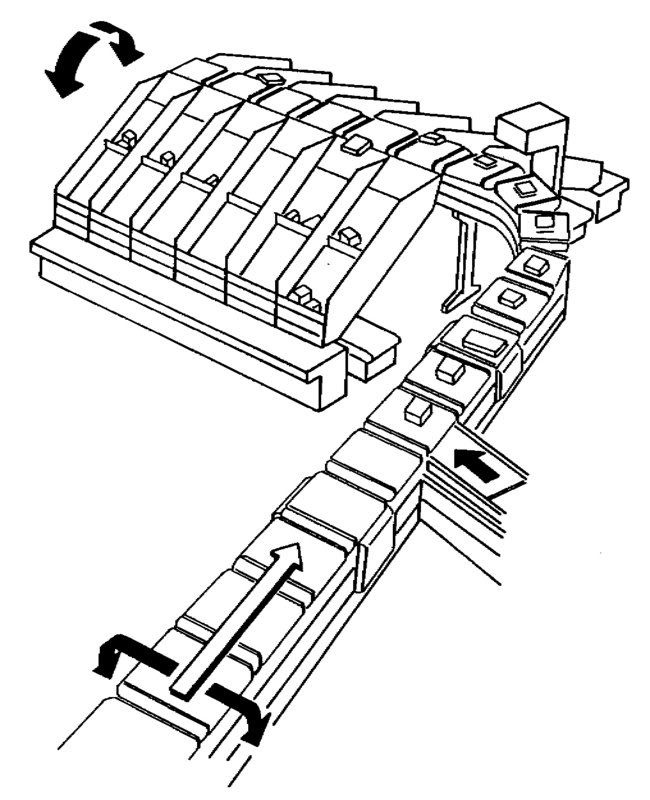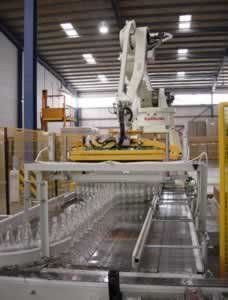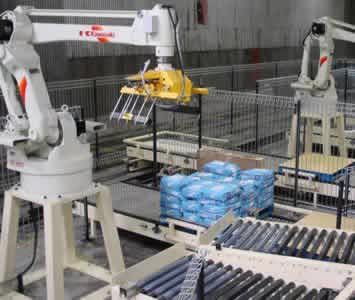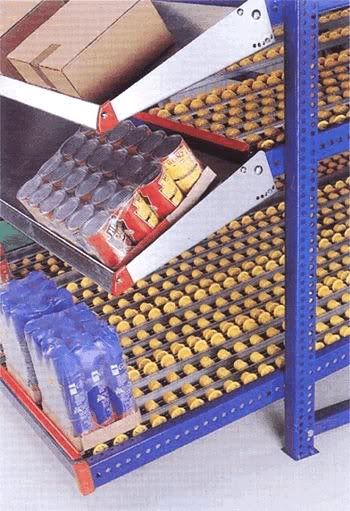The consideration factors will be our budget, cost to change from manual systems to fully automated systems. This two points are necessary is because if you dont have the money you wont be able to upgrade to a fully automated systems.
The other consideration factors will be throughput level and the space of our warehouse. If the throughput level is low it may not be sensible to change into a fully automated systems as high cost will be incurred. There is also a space constraint, if space doesnt allow you to change to fully automated, you wont be able to do so.
Considerations such as opportunity cost also need to be considered as it ties up capital as investment cost for automated systems are high. The goods you handle also determine the way you handle your items, your goods may not suit fully automated systems.
By using fully automated systems, less labours are also used and skilled labours are needed to handle the machines.
The layout of the warehouse, factors like floor space, ceiling height and structural obstruction may not allow us to change into automated systems. link | posted by <$T03$> at 7:46 AM
0 comments
Chelsea & Scott
No more backlog with Hytrol conveyor system
Chelsea & Scott, a.k.a. One Step Ahead, located in Lake Bluff, Illinois, was founded in 1988. The company is a distributor of toys, clothing, and accessories for children infant through eight years old. The company uses a 105,000 sq. ft. distribution facility to fill orders. About 150 workers are employed here. Prior to the installation of the Hytrol system, the facility used gravity lines. Workers picked into totes, then manually pushed the totes to the packers. After packing, the orders were pushed to the case sealer, then to outbound scanning, and finally to shipping. This method caused backlogs on the entire line, especially in the shipping area.
 Boxes would pile up there before being loaded on outbound trucks.
Boxes would pile up there before being loaded on outbound trucks.The firm realized the issues in their system and, with their increased business, knew a solution had to be found. They wanted to eliminate slowdown in the movement of the product going out the door and provide a smooth flow in the entire operation. They wanted a system that would make better use of the manpower in the operation, allowing all employees to be productive. They wanted a system which would handle current as well as future needs. They did not want to make another investment in the near future. Finally, they wante
 d a way to automatically move the used totes back to the pick location to begin the process again.
d a way to automatically move the used totes back to the pick location to begin the process again.Conveyor Solutions, a Hytrol distributor located in Schaumburg, Illinois, lived up to their name by providing the perfect system to handle Chelsea & Scott’s needs.
"We no longer have to push the totes through the entire facility to get the order out the door,"
 says David Kizer, director of distribution for Chelsea & Scott. "The pick tote can be placed on the conveyor in the back of the warehouse and move all the way to the pack station without intervention. The highest payback may be at the outbound scanning area. Before, this area was continually jammed with product. We had two or more people working in close quarters and always behind on the scanning/weighing process. Now, a single employee can run this area comfortably with minimal lifting of product."
says David Kizer, director of distribution for Chelsea & Scott. "The pick tote can be placed on the conveyor in the back of the warehouse and move all the way to the pack station without intervention. The highest payback may be at the outbound scanning area. Before, this area was continually jammed with product. We had two or more people working in close quarters and always behind on the scanning/weighing process. Now, a single employee can run this area comfortably with minimal lifting of product."How the System works: Order sheets are taken to the picking area to the proper zone. Orders are picked into totes, several at a time, until the order is completed.
 The tote is then placed on the outbound conveyor which takes it to the packers. The packers scan the order sheet in the tote and each item on the sheet is displayed on their PC. All items are then scanned and verification is made that the order is complete. The products are then placed in the appropriate size shipping box, the shipping label attached, and the box is placed on the outbound conveyor. Once the box is taped, it is moved along the line through a series of photo eyes that determine to which outbound ramp it will be sent. This is determined by workload. The box is then weighed and scanned a final time to create a shipping manifest. The scanned boxes are placed on a takeaway conveyor where the boxes are sorted based on the shipping carrier.
The tote is then placed on the outbound conveyor which takes it to the packers. The packers scan the order sheet in the tote and each item on the sheet is displayed on their PC. All items are then scanned and verification is made that the order is complete. The products are then placed in the appropriate size shipping box, the shipping label attached, and the box is placed on the outbound conveyor. Once the box is taped, it is moved along the line through a series of photo eyes that determine to which outbound ramp it will be sent. This is determined by workload. The box is then weighed and scanned a final time to create a shipping manifest. The scanned boxes are placed on a takeaway conveyor where the boxes are sorted based on the shipping carrier.Adapted from: http://www.conveyorsolutions.com/chelsea-scott.html
System Hy-lites
Facility Size:
105,000 sq.ft.
Employees:
150
Product Handled:
Toys, clothing and accessories for infants to eight years old.
Throughput:
5,000-6,000 cases a day
Types of Conveyors:
ACC, ABA, ABEZ, & LRC as well as gravity roller & skatewheel
Case Study 2
Faster Recharge battery for forklift!
Article adapted fromhttp://www.pressdisplay.com/pressdisplay/viewer.aspx
Quick recharging vehicle battery
Toshiba plans to make a quickcharging new battery for forklifts, construction machinery and other industrial use.
Toshiba Corp.’s Super Charge ion Battery, to start shipping in March, can recharge to 90 percent of its full capacity in less than five minutes, Toshiba spokeswoman Hiroko Mochida said.
Toshiba, a newcomer in rechargeable batteries, said the new lithium-ion battery, with a life span of 10 years, could be used in hybrid and electric cars by 2010, Mochida said.
Battery innovations are expected to be key in making hybrid vehicles more widespread because lighter and easier-to-recharge batteries will make it easier to offer variety among hybrids. And they will allow vehicles to travel farther on electricity.
“This is a truly innovative battery,” said Toshiba Corporate Vice President Toshiharu Watanabe.
The new battery will first be used in electric bicycles, motorcycles, forklifts and construction machinery. It can work in temperatures as low as minus-22 degrees Fahrenheit.
Most lithium-ion batteries in use now, such as those in laptop computers, require hours to recharge to full capacity, with the fastest ones requiring about half an hour.
Toshiba also said its new battery is unlikely to rupture or catch fire, problems that have beset some lithium-ion batteries used in laptops.
The Tokyo electronics-maker expects global sales of the new fast-charging battery to reach $893.7 million by fiscal 2015.
Case Study 3
TCJ turns focus to forklifts
 Diversifies into distributing Italian manufacturer’s trucks after slump in building projects
Diversifies into distributing Italian manufacturer’s trucks after slump in building projectsSasithorn Ongdee The Nation
Co n s t r u c t i o n supplier TCJ Asia hopes to garner a share of the Bt4billion domestic forklift market in its first year of operation in that area after suffering from a shrinking number of construction projects.
Managing director Songwoot Graipaspong yesterday said the constructionequipment distributor had extended its product line to include forklifts and industrial vehicles targeted at the manufacturing, transp o r t a t i o n and logistics industries.
The company’s main business is distributing heavy equipment and cranes and m a k i n g s t a i n l e s s - steel tubes.
TCJ Asia recently became the sole distributor in Thailand, Laos, Cambodia and Burma for leading Italian manufacturer OM Carrelli Elevatori. The OM brand covers a full range of forklifts and industrial vehicles.
“ This move will surely support TCJ Asia in operating fully in the industrial and logistics markets,” Songwoot said.
Chairman Nibhat Bhukkanasut said TCJ Asia’s prices for forklifts, starting at Bt600,000, would be close to those of its Japanese rivals, which enjoy a combined market share of more than 80 per cent.
Songwoot said that as Thailand was one of the Southeast Asian countries with high potential in industrial development, forklifts were considered essential for handling and transporting raw materials, component parts and finished products in manufacturing facilities and logistics outlets.
OM- brand forklifts will better serve the market with superior product quality, he said.
The company offers leasing, hire-purchase and maintenance services for its forklift customers. “ The company expects to sell about 100 forklifts in the first year of operation, with 10- per- cent a n n u a l growth,” he said.
An OM C a r r e l l i E l e v a t o r i survey showed Thailand was the biggest importer of forklifts in the region.
The company will attend the Thailand International Logistics Fair 2007 next week at the Bangkok International Trade and Exhibition Centre, where it will promote its new OM forklifts.
The firm posted a firsthalf net profit of Bt14.43 million on sales of Bt451.3 million. It has total assets of Bt1.66 billion and total liabilities of Bt646 million.
Nibhat said if the company succeeded in meeting its target volume for forklift sales, then it would likely expand its relationship with the OM brand.
link | posted by <$T03$> at 4:17 AM
0 comments



Material handling is the science of movement, handling and storage of material during transportation. It is a primary activity in all industries and involves numerous people and specialized material handling equipment.
Objectives of Material Handling Equipment
It is to prevent damages, to ensure that the goods are in good condition from the point of receiving to shipping so that good can be delivered to customers on-time.
It also improves productivity by making use of material handling equipment. Allowing labor to learn new technology and increase efficiency in moving more goods at a greater distance.
If one sees long queues at supply and dispatch areas or if one receives goods in a damaged condition or at a date much later than the expected date of delivery, it’s definitely a case of bad material handling.
Two main factors that affect material handling are related to engineering and economics.
The nature of the material to be handled and the material handling equipment are the factors related to engineering.
The cost of handling the material and the equipment used are related to economics.
During the last few decades, handling of material has become highly automated. Computers are being widely used to systematize material handling.
Material handling is considered an important activity along all the links of the supply chain, which include production, distribution, storage and retail. Minimizing the complexity of handling operations can increase productivity and cut costs.
Material handling equipment
It is equipment that is specifically designed for mechanically handling packaged or bulky items, generally in a production, shipping or storage facility. Selecting the right material handling equipment is vital, as it affects the operating cost and operational efficiency of a factory. The material to be handled, the plant building, and the issues of urgency and safety are a few factors that affect the decision on selecting the right material handling equipment.
The material handling equipments can be classified into:
- Information-Directed System
- Automated handling
- Semi-automated handling
- Mechanised system
0 comments
It is the combination of using automated handling syetm and mechanised system. Let's dicuss one of the method which uses information- directed system.
RF (radio- frequency)
Wirelessly transmitting data can provide tremendous time and cost savings.
RF is the wireless transmission of data by digital radio signals at a particular frequency. It maintains a two-way, online radio connection between a mobile terminal and the host computer. The end result is a seamless flow of information to and from the host, allowing workers to go wherever they need to go to get their job done without fear of being out of touch wiith the data they need.
A basic RF system consists of up to three components:
• A mobile RF terminal;
• A base station (sender/receiver); and
• A network controller.
How RF is used in Warehouses and Distribution Centers
Shipping and receiving
When goods arrive at receiving area, the bar code on the pallet is scanned and the data is sent to the host computer. At the same time, the amount of goods received can be compared with the amount ordered so as to determine if there is any disparity. Immediate actions can be taken if goods received are different from the order or are damaged. The goods are therefore quickly processed and sent along to their destination, be it the warehouse, production department or shipping/staging area.

Internal transport
Goods do not remain stationary when instructions are sent wirelessly direct to the mobile terminal. Forklift truck operators need not have to go somewhere specific to get their instructions; rather, the instructions come to them, saving time, eliminating deadhead trips and making more productive use of personnel and materials. Also, a RF system allows stock retrieval and replenishment to be combined, significantly reducing the number of movements involved in the internal transport of material.
Stock and location management
The moment palletized goods are put away, forklift operators can use their computer to notify the host system of their location and that they are ready for another job. This allows warehouse space and workers' time to be used in a more efficient manner as they had reduced unneccessary movements.

Order picking
RF supports all possible order picking principles: individual selection, batch selection or
splits between articles and packaging. Picking information is received by the terminal,
and inquiries and transaction/activity data are sent from the terminal to the host. Once the order is picked, a forklift truck operator can then be given delivery instructions from a warehouse management system (WMS) via RF. This enables the Warehouse Management System to continually recalculate the most efficient pick/putaway routes and order assignments.

Stock control
Using RF for stock control offers huge savings in time and money. As all events are
recorded in real time, the computer is constantly aware of the current inventory. This
high level of monitoring makes separate cycle counting unnecessary. Many
companies reduce the number of formal inventory counts they conduct each year, and in
some cases eliminate them altogether because the RF system provides accurate, real-time
inventory information.
Stock replenishment
Each time stock is removed, the transaction is recorded by the mobile terminal and sent to
the host. When stock reaches minimum, the system would alert a supervisor or automatically generate a replenishment request. When bulk stock reaches
order level, a purchase order is automatically created and an order placed. Reordering is
instantaneous; stocks can be kept low, therefore reducing inventory costs.
The RF advantage
Reducing the number of cables over the warehouse-Cable is expensive, less flexible than RF coverage and is prone to damage.
Accessibility is a key benefit- Data is easily accessible to workers when they are within range of the system. Therefore, they will not be out of touch of information.
RF also include a significant improvement in order accuracy (>99%), the elimination of paperwork (which could be prone to loss of data), prompt response times and improved service levels. link | posted by <$T03$> at 9:48 PM
0 comments
1) ASRS ( Automated storage and retrival systems)
ASRS refers to a variety of computer-cotrolled methods for automatically placing and retriving loads from specific storage locations.


How ASRS works?
Step 1: Bin call by operator using barcode, keyboard or process .

Step 2: Simultaneous traverse and lifting movements to position table in front of selected bin,

Step3: Load pick-up and contour check before transfer.

Step 4: Simultaneous traverse and lifting movements to bring bin to operator.
Step 5: Part pick-up.
Step 6: Bin return to sight-hole at operator request
Step 7 : Bin deposit. Table back-off. Stand by for new orders.
Step 8: Dynamic location management.
In a more complex automated operations, ASRS software consists of:
a) Monitoring and controlling the complex transportation system moving loads into and out of ASRS equipment, including operations of conveyor systems transfers, pallet, elevators etc and also rejecting those loads which are not able fit into the storages.
b) Visibly identifying loads for quantity, part number and manufacturer and updating the inventory plus.
c) Assigning specific address for each individual load. Locating the goods to specific aisles according to their specifications.
d) It can retrive loads based on either FIFO ( First-In-First-Out) or FILO (First-In-Last-out).
Advantages of ASRS:
-Bringing material to the operator and reducing cycle time by removing wait, movement, and search time.
-Reduces work-in-progress inventory. Better inventory accuracy and better responsiveness in reduction or elimination of “buffer stock” in the overall inventory model. This has the net effect of inventory reduction.
-Dramatically increases operator productivity. The “Part to Picker” model of order fulfillment is 3 to 5 times more productive that having the picker travel to the part to complete the fulfillment .
-Provides real-time inventory control with instant reports. Almost 100% accuracy and real time information about the inventory on hand, achievable commitments can be made to your customer – as opposed to “best efforts promises”.
-Improves product quality and productivity. Real time information, faster response to a need, physical protection, and traceability of material access all contribute to a better process where time can be spent on improving the quality of the process instead of on expediting material to a point of use.
Order Selection Systems:
It is a method of operating the system for retrieving multiple types of items stored in pre-selected storage locations and delivering retrieved items in an orderly sequence to the packing stations in accordance with specific requirements of different orders.
The order selection system consists:
A dispenser

A conveyor

A dispensing control system;
A sorter;

Stacking devices; link | posted by <$T03$> at 9:47 PM
0 comments
Types of semi-automated handling equipments are
- Automated-Guided Vehicle (AGV)
- Sortation
- Robotics
- Live Racks
1. Automated-Guided Vehicle (AGV)
The Automated Guided Vehicle or Automatic Guided Vehicle(AGV) is a mobile robot used in Manufacturing and Distribution operations to move materials around a the facility or a warehouse.
Characteristics
- incorporate battery-powered driverless vehicles with programming capabilities for path selection and positioning.
- They are equipped to navigate a flexible guide path network that can be easily modified and expanded.
An AGV system can vary in size from a short pick-up and delivery arrangement to a complex layout with computer controlled vehicles automatically interfacing with other automated manufacturing equipment.
Navigation
AGVs navigate around with sensors. There are two main sensors AGVs use for navigation, a wired and a wireless sensor.
Wired Sensors
The wired sensor is placed on the bottom of the robot and is placed facing the ground. Another wires is placed 1 inch below the ground. The sensor detects the radio frequency being transmitted from the wire and follows it. If the AGV is put off course the AGV will correct itself and continue to follow the wire.
Wireless Sensors (Laser Target Navigation)
The wireless navigation is done by mounting reflective targets on poles or machines. The AGV carry a laser transmitter and receiver on a rotating turret. The laser is sent off then received again the angle and distance are automatically calculated and stored into the AGV’s memory. The AGV has a grid stored in its memory and can find its location by reflecting the laser off the targets.It can then navigate to a destination target through the grid and the constantly updating sensor.
Wireless Sensors (Gyroscopic Navigation)
Another form of a wireless AGV is gyroscope navigation. This method involves using a gyroscope to detect the slightest change in the direction of the robot. Magnets are installed in the ground of the work place and the AGV detects these magnets with a sensor. The magnets is an insurance factor that it is on course. The gyro detects the slightest turn and corrects it in order to keep the AGV on its path.
Steering Control
To help and AGV navigate it can use two different steer control systems. The differential speed control is the most common and has two sets of wheels being driven.
Each set is connected to a common drive train. These drive trains are driven at different speeds in order to turn or the same speed to allow the AGV to go forwards and/or backwards.
This method of steering is good as it is easy to maneuver in small spaces. More often than not, this is seen on an AGV that is used to transport and turn in tight spaces or when the AGV is working near machines. This setup for the wheels is not used in towing applications because the AGV would cause the trailer to jackknife when it turned.
The other type of steering used is steered wheel control AGV. This type of steering is similar to a cars steering. It is more precise in following the wire program than the differential speed controlled method.
This type of AGV has smoother turning but cannot make sharp turns in tight spots. Steered wheel control AGV can be used in all applications; unlike the differential controlled.Steered wheel control is used for towing and can also at times have an operator control it.
Battery charging
AGVs utilize a number of battery charging options. Each option is dependent on the users preference.
There are three ways to do AGV battery charging:
- Battery Swap
- Automatic/Opportunity Charging
- Automatic Battery Swap
Battery Swap-Out
It requires an operator to manually remove the discharged battery from the AGV and place a fully charged battery in its place approximately 8 - 12 hours (about one shift) of AGVs operation.
Most AGVs have rollers in the battery compartment to facilitate the battery exchange. Typically, the battery is rolled on to a battery cart. This cart then moves transversely across the face of a row of battery charges, each equipped with a battery stand. The used battery is exchanged with the fresh battery, which is then replaced in the vehicle. Batteries in vehicles can also be exchanged using an overhead hoist. Battery swap-out can also be performed by an automated battery change system.
Each AGV utilizes a single maintenance-free battery that normally stays in the AGV. The AGV has an automatic charge shoe mechanism that allows the AGV to make contact with a copper contact plate in the floor. This contact plate is wired through the floor to an automatic charger mounted on a column or wall nearby.
When the AGV stops over the contact plate and its charge mechanism contacts the plate, the charger automatically turns on. The AGV remains on charge until needed for a load transport task.
When it departs, the charger automatically turns off. On average an AGV charges for 12 minutes every hour for automatic charging and no manual intervention is required
It is an alternative to manual battery swap. It requires an additional piece of automation machinery, an automatic battery changer, to the overall AGV system. AGVs will pull up to the battery swap station and have their batteries automatically replaced with fully charged batteries. The automatic battery changer then places the removed batteries into a charging slot for automatic recharging. The automatic battery changer keeps track of the batteries in the system and pulls them only when they are fully charged.
Tow Type/ Cart Vehicles Utilizes a fork/mast lift mechanism for interfacing with loads at various elevations. Often loads are at floor or stand level and are retrieved and deposited automatically. How safe are AGVs compared with other material handling methods? It is due to a number of factors. They travel at 2 mph, which is walking speed. They have numerous safety devices to prevent accidents such as flashing lights, audible devices, physical emergency bumpers, passive infrared and sonar devices. In addition, ANSI regulations specify layout requirements, stopping distances and other safety related items to insure safe implementation of AGV systems. Conveyor systems allow quick and efficient transportation for a wide variety of materials, which make them very popular in the material handling and packaging industries. Many kinds of conveying systems are available, and are used according to the various needs of different industries. Stationary or movable arms that deflect, push, or pull a product to desired destination Sortation Conveyor: Pop-Up Device One or more rows of powered rollers or wheels or chains that pop up above surface of conveyor to lift product and guide it off conveyor at an angle; wheels are lowered when products not required to be diverted Sortation Conveyor: Sliding Shoe Sorter Sortation Conveyor: Tilting Device Trays or slats provide combined sorting mechanism and product transporter Sortation Conveyor: Cross-Belt Transfer Device Either continuous loop, where individual carriages are linked together to form an endless loop, or train style (asynchronous), where a small number of carriers tied together with potential for several trains running track simultaneously Vertical sortation conveyor Sorter –sort the baggage flow from one transport conveyor to two transport conveyors at different vertical levels. Merger –merge the baggage flows from two transport conveyors at different vertical levels into one transport conveyor either in upward or downward direction. 3. Robotics Robotics are also used to meet the high demands of palletizing .Especially useful in present highly competitive marketplace,the demand for just-in-time deliveries, flexible packaging, the freshest products, safe work environments, and the highest production line efficiencies. 4. Live Racks Live pallet gravity flow rack permits dense storage by eliminating all aisles except the entrance and exit aisles. Carton gravity flow rack Carton and Pallet Flow Rack Styles provides lanes of pallet storage that store pallets at an angle. Each lane of pallet positions has frames with built-in wheels that act like conveyors for advancing pallets forward by gravity as pallets are removed from the rack system. Pallet Flow Rack is used to store multiple pallets of each SKU. Flow Storage consists of two clearly defined elements: Rack Structure and Dynamic Flow Rails. The flow rails are set at an incline in the rack structure, allowing pallet loads placed on one end of the rack to move down ot the unloading end. Rollers facilitate smooth rolling, while self-energizing brakes control the speed. As each load is removed, the loads behind move forward automatically. Flow system depth, height and width is limited only by the size of your facility and capabilities of your material handling equipment. Various rack structure designs may be used to support the flow rail system being used. A roll formed or structural rack design may be used. A flow storage system is only as good as the rack structure used to support the flow rail system. Conveyor rail components consisting of various types of wheel or roller rail best suited to flow the product stored. These components are the most decisive to determine whether a flow system will be successful. These components are set at a decline to move product from one location to another. The flow rails allow loads to move by gravity from the loading end to the unloading end. Each flow lane includes self-energized speed controllers (brakes) to gently control the speed of movement within the flow lanes. As a load is removed, the loads behind it move forward to the unloading position. Pallets Types of Pallets Stringer Pallet Stringer pallets are also known as "two-way" pallets, since a pallet-jack may only lift it from two directions instead of four. The stringers are the boards located between the top deck boards and the bottom deck boards. The pallets name is derived from these boards, which are actually called the stringer boards. Block Pallet Wooden pallets are used as: Many of these "four way" pallets are color coded according to the loads they can bear, and other attributes. Paper Pallets Plastic Pallets Made of a plastic resin which is more durable and lighter weight than most plastics.
In manufacturing industry In warehouse or distribution
In warehouse or distribution 
Commercial/Office Type/ Light Load AGVS
Smaller type units with capacities of less than 500 pounds. Designed to transport small totes or small loads in light manufacturing or clean environments. Versions are also used to distribute mail in offices.
Heavy Carrier Type
Designed to transport large or very heavy loads. Typically used in primary metal and paper industries. Capable of transporting dies, rolls, coils, ingots weighing in excess of 250,000 pounds.
Benefits
AGVs are very safe, particularly when compared with manual material handling methods. There are hundreds of injuries per year resulting from manual forklifts, however there are probably less than a dozen AGV injuries per year.
2. Sortation
Conveyors have limited access area and high hardware cost, therefore is only suitable for very high volume operations.
A conveyor system is a common piece of mechanical handling equipment that moves materials from one location to another. Conveyors are especially useful in applications involving the transportation of heavy or bulky materials.
Conveyor systems are used widespread across a range of industries due to the numerous benefits they provide. 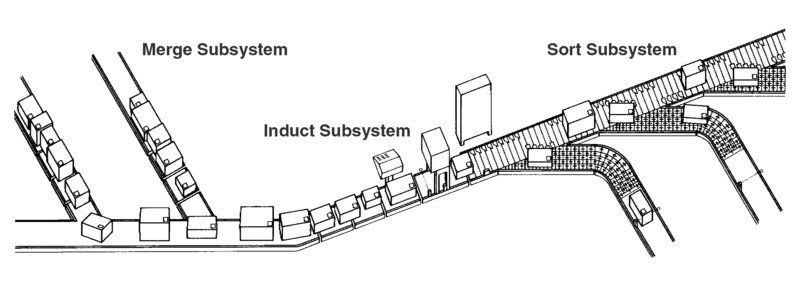
Sortation conveyors are used for merging, identifying, inducting, and separating products to be conveyed to specific destinations
Since they do not come in contact with the conveyor, they can be used with almost any flat surface conveyor
Usually hydraulically or pneumatically operated, but also can be motor driven
Simple and low cost
Only capable of sorting flat-bottomed items
Pop-up rollers are generally faster than pop-up wheels
Sliding shoe sorter (a.k.a. moving slat sorter) uses series of diverter slats that slide across the horizontal surface to engage product and guide it off conveyor
Slats move from side to side as product flows in order to divert the product to either sideGentle and gradual handling of products
Can accommodate elevation changes
Tilt tray sorters usually designed in continuous loops with a compact layout and recirculation of products not sorted the first time
Tilt slat sorters carry products on flat-surface slat conveyor and can handle wider variety of products compared to tilt tray
Each carriage equipped with small belt conveyor, called the cell, that is mounted perpendicular to direction of travel of loop and discharges product at appropriate destinationAutomatically separates single line of products into multiple in-line discharge lines
The Vertical sortation conveyor is used to perform either of the following types of functions in a baggage handling system.
This application makes use of the robot's capability to transport objects. By fitting the robot with an appropriate end-effector (e.g., gripper), the robot can grasp the object that needs to be moved.
The robot may be mounted either stationary on the floor, enabling it to move from one workstation to another. The robot can also be ceiling mounted.
The primary benefits of using robots for material handling are:
Robots that are used for material handling can interface with other material handling equipment such as:
The following are examples of material handling applications:
Examples of palletizing functions include:
The configuration of live pallet gravity flow rack makes it ideal for
Live pallet gravity flow rack can be integrated into an automated and storage retrieval system (AS/RS)for even greater efficiency. This versatile rack design saves space, labor costs, and energy by efficiently utilizing gravity. The advantage of gravity flow rack include: 
provides an economical method for both split and full carton order picking. With carton gravity flow rack, stockers load the rack from the back while the cartons glide down wheel tracks to the picking faces utilizing gravity as the free power source.
The advantages of carton gravity flow rack include:
Pallet Flow Racking
Because product flows down tracks to the face of the rack, empty slots are at the rear of the rack and can be replenished without sacrificing first-in/first-out stock rotation, and without interrupting order picking. Pallet flow rack is often used for picking cases and in high volume applications that use a conveyor, as in a “pick-to-belt” system that handles fast moving SKUs.
Rack Structure
Dynamic Flow Rails
The flow system depth, height, and width are limited only by the size of your facility and the capabilities of your material handling equipment.
designed to support a variety of goods in a stable fashion while being lifted by any mobile forklift, pallet jack, or other jacking device. The goods are placed on top of the pallet, and can be secured to it by straps or stretch-wrapped plastic film.
All pallets fall into two very broad categories: "stringer" pallets and "block" pallets.
Stringer pallets use a frame of three parallel pieces of timber (called stringers). The top deckboards are then affixed to the stringers to create the pallet structure.
The stringer boards are either solid or notched depending on the application. If the stringer boards are notched as shown it allows for a partial 4-way entry into the pallet. It is only a partial 4-way entry pallet because you can only get under the pallet with a pallet jack from the front and not the side.
Block pallets are typically stronger than stringer pallets. Block pallets utilize both parallel and perpendicular stringers to better facilitate efficient handling. A block pallet is also known as a "four-way" pallet, since a pallet-jack may be used from any side to move it. The side picture is of a Block design pallet. Block or Post pallets can be partial or full four-way entry. The typical block pallets can have 4-12 blocks as support for the top deck boards or mat. The length of the stringer board determines a Block pallets length, which is located between the top deck and the top of the blocks. The length perpendicular to the stringer length determines the width. Block pallets can have a variety of bottom deck configurations. There may be no bottom boards, boards parallel to the deck boards or a full parameter base similar to a picture frame.
pallets are of a very simple construction which permits lifting from one of two opposite positions only. Slightly more complex hardwood pallets and most plastic pallets and metal pallets can be lifted from all four sides. These costlier pallets usually require a deposit and are returned to the sender or resold as used.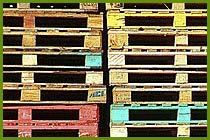
Wooden pallet construction specifications can depend on the pallet's intended use: general, FDA, storage, chemical, export; the expected load weight; type of wood desired: recycled, hard, soft, kiln Dried or combo (new & recycle); and even the type of fasteners desired to hold the pallet together: staples or nails.
Plastic pallets can not easily be repaired when broken which is why they are mostly used by logistics service providers who can easily replenish stock for its customers.
Plastic pallets offer several benefits over traditional materials like wood: depending on the type of plastic,
· they can be weather
· odour-resistant
· easily be sanitized for international shipping
· work better with toxic materials for purposes of sanitation and plastics are impervious to most acids.
0 comments

Forklift truck can move loads of master cartons both horizontally and vertically. A forklift truck, a lift truck, a High/Low or a forklift and sideloader is a powered industrial truck used to lift and transport materials, normally by means of steel forks inserted under the load. Forklifts are most commonly used to move loads stored on pallets.It has since become an indispensable piece of equipment in manufacturing and warehousing operations.
Design types

There are many national and/or continental associations related to the industrial trucks. The three major ones are the Industrial Truck Association (North America), the Fédération Européenne de la Manutention (Europe), and the Japan Industrial Vehicles Association (Japan). There are many significant contacts among them and they have established joint statistical and engineering programs. One program is the WITS (World Industrial Trucks Statistics) published every month to the association memberships.
 List of the more common truck types, from the smallest to the biggest:
List of the more common truck types, from the smallest to the biggest:Hand Pallet Truck
Walkie low lift truck (powered pallet truck, usually electrically powered)
Rider low lift truck
Towing tractor
Walkie stacker
Rider stacker
Reach truck (small forklift, designed for small aisles, usually electrically powered)
Electric counterbalanced truck
IC counterbalanced truck
Sideloader
Telescopic handler
Slip Sheet machine
Walkie Order Picking truck
Rider Order Picking truck (commonly called an "Order Picker"; like a small forklift, except the operator rides up to the load and transfers it article by article)
Characteristics
A typical 'Counterbalance' forklift may be generally described as follows:
- The truck proper, which is a motive machine with wheels or tracks powered through a drive train.
- A liquefied petroleum gas–, petrol- or diesel fueled internal combustion engine, or an electric motor(s) either direct current or alternating current powered by either a battery or fuel cells.
- The mast, which is the vertical assembly that does the work of raising, lowering, and tilting the load; the mast is either hydraulically operated consisting of one or more cylinder(s) and interlocking rails for lifting and lowering operations and for lateral stability, or it may be chain operated with a hydraulic motor providing motive power.
- The carriage, which comprises flat metal plate(s) and is moved along the mast either by means of chains, or by being directly attached to the hydraulic cylinder.
- Counterbalance machines have a counterweight, which is a heavy iron mass attached to the rear of the machine, necessary to compensate for the load. In an electric forklift, the large lead-acid battery itself may serve as part of the counterweight.
Guided Very Narrow Aisle trucks
These are rail or wide guided and available with lift heights up to 12 metres (40') non top-tied and 30 metres (98') top-tied. Two forms are available; 'man-down' and 'man-riser' where the operator elevates with the load for increased visibility or for multilevel 'break bulk' order picking. This type of truck, unlike Articulated Narrow Aisle Trucks, requires a high standard of floor flatness.
Control and capability
Forklift trucks are available in many variations and load capacities. In a typical warehouse setting most forklifts used have load capacities of around one to five tons, though machines of over 50 tonnes capacity have been built and operated.
In addition to a control to raise and lower the forks (also known as blades or tines), the operator can tilt the mast to compensate for a load's tendency to angle the blades toward the ground and risk slipping off the forks. Tilt also provides a limited ability to operate on non-level ground. Some machines also allow the operator to move the tines and backrest laterally (side-shift), allowing easier placement of a load. To aid the handling of skids that may have become excessively tilted and other specialty material handling needs, some forklifts are fitted with a mechanism that allows the tines to be rotated. In addition, a few machines offer a hydraulic control to move the tines together or apart, removing the need for the operator to get out of the cab to manually adjust for a differently sized load.
Forklift Safety
Forklift safety is subject to a variety of standards world wide. The most important standard is the ANSI B56—of which stewardship has now been passed from the American National Standards Institute (ANSI) to the Industrial Truck Standards Development Foundation after multi-year negotiations. ITSDF is a non-profit organization whose only purpose is the promulgation and modernization of the B56 standard.
Other standards have been promulgatd by the U.S Occupational Safety and Health Administration and the United Kingdom's Health and Safety Executive. Lift truck operators must be trained and certified.
Four companies dominating the market
-Toyota IndustriesCorporation (3.47 M€ in '03/04)
-KION Group(2.94 M€ in '03)
-Jungheinrich (1.35 M€ in '03)
-NACCO Industries, Inc.(NMHG) (1.27 M€ in '03) with Yale and Hyster Brands
The following is a hyperlink to the history of forklift
http://www.datakey.org/mhedajournal/3q04/lifttrucks_a.php3\References:http://en.wikipedia.org/wiki/Forklift
Conveyor

A belt conveyor consists of two or more pulleys, with a continuous loop of material - the conveyor belt - that rotates about them. One or both of the pulleys are powered, moving the belt and the material on the belt forward. The powered pulley is called the drive pulley while the unpowered pulley is called the idler. There are two main industrial classes of belt conveyors; Those in general material handling such as those moving boxes along inside a factory and bulk material handling such as those used to transport industrial and agricultural materials, such as grain, coal, ores, etc. generally in outdoor locations.
The belt consists of one or more layers of material. Many belts in general material handling have two layers. An under layer of material to provide linear strength and shape called a carcass and an over layer called the cover. The carcass is often a cotton or plastic web or mesh. The cover is often various rubber or plastic compounds specified by use of the belt. Covers can be made from more exotic materials for unusual applications such as silicone for heat or gum rubber when traction is essential.
Wide variety of related conveying machines are available, different as regards principle of operation, means and direction of conveyance, including screw conveyors, vibrating conveyors, pneumatic conveyors, the moving floor system, which uses reciprocating slats to move cargo, and roller conveyor system, which uses a series of powered rollers to convey boxes or pallets.
Conveyors are used as components in automated distribution and warehousing. In combination with computer controlled pallet handling equipment this allows for more efficient retail, wholesale, and manufacturing distribution. It is considered a labor saving system that allows large volumes to move rapidly through a process, allowing companies to ship or receive higher volumes with smaller storage space and with less labor expense.
Typical Construction of a Conveyor systems Belt Bend

Belt Conveyor systems at a Packing Depot

Baggage Handling Belt Conveyor systems

Few types of Conveyors
Snake Sandwich Belt Conveyor
A sandwich belt conveyor uses two conveyor belts, face-to-face, to gently but firmly contain the product being carried, hence making steep incline and even vertical-lift runs easily achievable. The Snake Sandwich Belt Conveyor was created in 1979. The study was conceived by Joseph A. Dos Santos, P.E., President of Dos Santos International, with the help of a grant from the U.S. Bureau of Mines. The study was to develop a means of moving and elevating large quantities of bulk materials, including coarse products such as rocks, aggregate, coal, etc. at the steepest possible inclines. The intent was to use only existing and generally available hardware in order to achieve the most economically feasible and easily maintained steep-angle conveyor design. Snake Conveyors are available in widely ranging profiles of C and S Shape. In any case, a long bottom belt approach is possible to the sandwich entrance, and discharge may be on the high incline or may be after the extension of the carrying belt beyond the mouth of the sandwich. Snake Sandwich conveyors offer several advantages. First unlimited conveying capacity, a system suitable for the most rugged mine applications and gentle on sensitive and friable materials, high availability and low operating and maintenance costs, smooth surfaced belts allowing continuous belt cleaning by scrapers and plows. This also facilitates intermediate material discharge by belt plows, as appropriate, before and/or beyond the sandwiched part of the Snake profile. All conventional conveyor hardware insures economy and fast delivery of replacement parts.
Vibrating Conveyor Systems
A Vibrating Conveyor is a machine with a solid conveying surface which is turned up on the side to form a trough. They are used extensively in food grade applications where sanitation, washdown, and low maintenance are essential. Vibrating conveyors are also suitable for harsh, very hot, dirty, or corrosive environments. They can be used to convey newly cast metal parts which may reach upwards of 1500°F. Due to the fixed nature of the conveying pans vibrating conveyors can also perform tasks such as sorting, screening, classifying and orienting parts. Vibrating conveyors have been built to convey material at angles exceeding 45° from horizontal using special pan shapes. Flat pans will convey most materials at a 5° Incline from horizontal line.
Flexible Conveyor Systems
The flexible conveyor is based on a conveyor beam in aluminium or stainless steel, with low friction slide rails guiding a plastic multi-flexing chain. Products to be conveyed travel directly on the conveyor, or on pallets/carriers.
Pneumatic Conveyor Systems
Products are moved through various tubes via air pressure, allowing for extra vertical versatility. Pneumatic conveyors are either carrier systems or dillute-phase systems; carrier systems simply push items from one entry point to one exit point, such as the money exchanging tubes used at a bank drive-thru window. Dillute-phase systems use push/pull pressure to guide materials through various entry and/or exit points.
Lets see a video on conveyor.
References
http://www.youtube.com/
http://en.wikipedia.org/wiki/Conveyor
Carousels
Horiziontal Carousel

-Horizontal carousels consist of an oval track with rotating bins containing shelves that deliver items to the operator. Often used in integrated workstations of carousels called a “pod.”
-It allows an operator to pick from one active carousel while the others are pre-positioning to be picked the moment the operator is ready.

-Vertical carousels consist of shelves that rotate up or down via the shortest path, delivering items to an ergonomically positioned pick window. The vertical design maximizes the use of overhead space and can recover up to 75% of the floor space required for traditional shelving systems.
-Vertical carousels are available in a wide range of heights, depths and widths to meet virtually any storage and retrieval requirement. They are compatible with an entire suite of software and controls to meet standard and unique applications.
Advantages
- Helps organizations meet Lean Manufacturing
- Brings inventory to point of use
- Shelves can be easily adjusted to meet future needs
- Improves operators productivity and ergonomics
- Higher MTBF (Mean Time Between Failure) rates than most household appliances
- Link multiple floors and/or areas with customizable pick windows
- Easy to use controls and/or multiple levels of software available
- Protect and/or secure single or multiple items
- More than 7,000 standard configurations
- Easily integrates bar code scanning and pick-to-light technology for increased throughput, productivity and accuracy levels
Carousels being an automated storage and retrieval system often provides advantages such as
- Increased throughput up to 600%
- Reduced floor space requirements up to 60%
- Flexible design provides instantly adjustable shelf levels
- Reduced labor up to 2/3
- Move and change workstation designs easily
- Workstation design that is easily modified Increased level of accuracy up to 99.9% levels
- The ability to increase or decrease a carousel's length easily
- Extended order cut-off times
- Fast ROI (Return On Investment)
References: http://www.remstar.com/ link | posted by <$T03$> at 9:37 PM
0 comments





